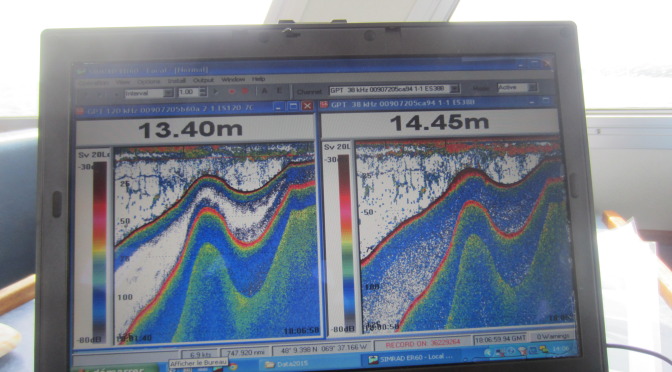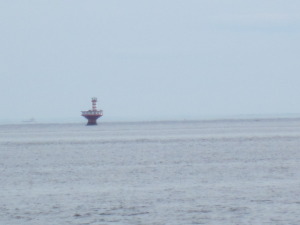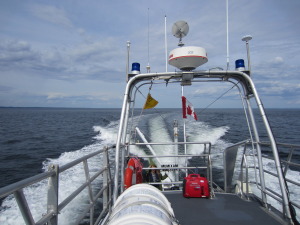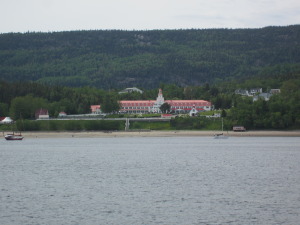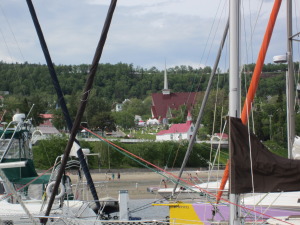About a month ago Parks Canada launched an invitation to anyone who might like to spend a half day on L’Alliance, their research vessel. Alan and I were lucky enough to get two spots on the second day and yesterday spent a fascinating afternoon on board with the Parks marine biologists.
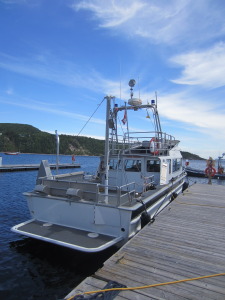
After everything was secured we headed out into the river to conduct two types of surveys. The boat itself is so impressive. Alan asked and there are two 330 HP engines.
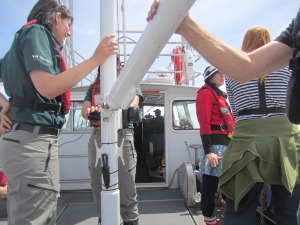
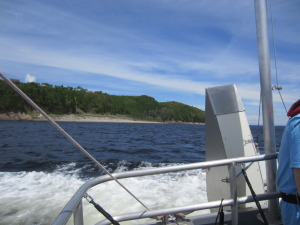
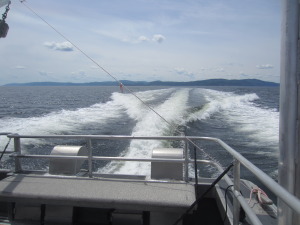
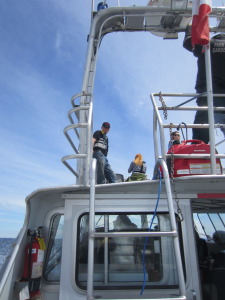
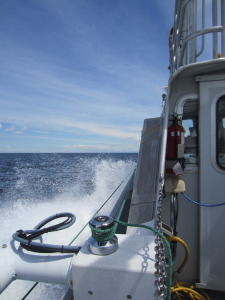
The first set of surveys that we observed was a machine taking Echo soundings off the bank where we were (off the large dunes for those who know the area). Other research vessels had seen large schools of fish and large schools of krill in recent days. Parks Canada likes to monitor the schools and determine where they are and when and what types (2 types of krill and 3 types of fish), as this will determine where the whales and other wildlife are feeding and moving in the St.Lawrence. They lowered the Echo scanner (this is not the proper name but I can’t remember it .) into the water and it can emit 3 levels of echo sound. We were looking primarily at 38Hz and 120Hz as these are the ones that pick up the krill and the fish.
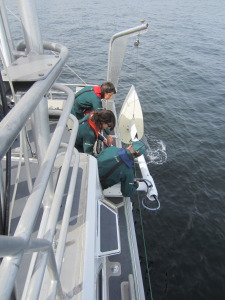
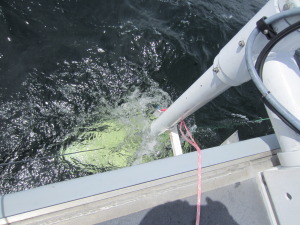
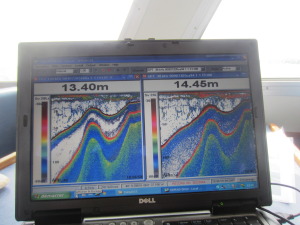
Although not so easy to see in this picture, we were watching for the red lines at the top of the right hand screen and the green stripe at the top of the left hand screen which were evidence of a large school of fish.
Everyone immediately started searching for whales and other wildlife and of course found them easily – minkes, fins and lots of sea birds. Everyone was madly scanning and trying to capture as many pics as possible. Each whale is marked by photo if possible – although they were in the distance – and by longitude and latitude. The minkes were as close to Tad as the sand dunes so they are getting closer to us. (In fact later that evening Christianne Stairs and her friends saw the first ones off Point Islet). The biologists said that it was not unusual to have the minkes come so late when the winter has been so harsh and everything else is late. Everything is all connected and temperature, currents, tides, weather all have impacts on the movement of the whales and the birds. The researchers told us it is a good sign that these schools of fish are staying in this area as it will encourage the whales. The schools may move at any time depending on the currents the winds etc.

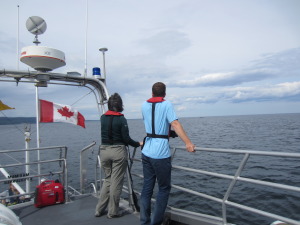
The second survey was to find the climate and environmental data to go with the sonar data. A Laboratory column was lowered into the water to take temperature, salinity, oxygen levels, etc. across the areas where the sonar data had been collected. This is then coupled with the sonar images to make a more thorough analysis of the environment .

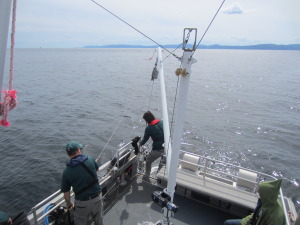
We were lucky as the day was spectacular and as a last gift on the way home we were followed by a very large pod of beluga. We asked about the research and the concerns related to the belugas in particular, but the whales and whale watchers as well.
It was a tough discourse as the biologist told us that while they were confident in 2010 that the population had stabilized they are not so secure now. The population is continuing to decline and is now below the 900 that they were keeping as their hopeful target. There are several hypotheses as to why but the two main ones are related to climate change and contamination in the waters (increasing levels of hormones in particular). In terms of climate change the seasons are changing. The winters are less severe, and then more severe, and the summers are longer and hotter. This effects the calving and the early development of the babies.
What they are also observing is that the “nouveau-né” (newborns) are dying and that the mothers of the young are also dying. This is leading them to question the horomonal imbalances that may be occurring in the whales themselves or how the females may be being impacted by the horomonal increases in the waters. In 2010 the number of young (1-2 yrs)within the population was 10%. It has now fallen to 3-5% and this is worrying in terms of longevity of the group.
A third and difficult reason for the decline relates to us as the human contacts. There has been a steady increase in pleasure boat activity over the last 5 years in our area. They are desperately trying to balance a need to have people see and understand the whale environment with the need for little to no stimulation during the calving season, and as little disruption of the natural whale habitat as possible in these crucial summer months of July and August. We asked about the regulations that are in place for belugas and for other whale groups.
For the belugas 400metres is the minimum. I said that often the belugas are curious and come towards us and they were very quick to say that we need to be vigilant in taking evasive action at all times to avoid any disruption of the pods particularly with young. They are attempting to reinforce very strongly the zone d’exclusion around the Rivière Ste. Marguerite as this is the breeding, calving and nursery region. They have observed from their site at the Marguerite that when a beluga calves she separates herself from the pod for a period of a couple of hours before and several hours after the birth. It is clear over many observations that disruption to these patterns may interfere with the maternal child bond in those early hours at a bare minimum and potentially increase the death rate.
For the other whale groups, I mentioned how it is difficult to watch a group of 6 or 7 boats surrounding one whale and seemingly tagging along and following it where ever it goes. Is this harassment? The biologist said that the regulations are that boats must be 1-200 meters away from all whales (belugas excepted as above). She also noted that all captains receive information and follow the rule that if there are already 4 boats and a 5th arrives that all must recede away from the whale. If it is a solitary whale there is a 1 hour watch limit then they must go elsewhere. She also noted that the captains have become real allies in their work as it is their livelihood as well. She mentioned that often the captains are reporting boaters that do not follow the rules and are constantly sending them observations, updates and pics of the whales for their records.
It was a wonderful afternoon and as we headed back in to the marina I had an interesting discussion with one of the other guests. She was enjoying the atmosphere, the beauty and the learning that had taken place and when she found out that we actually lived here year round she said “You must feel like the luckiest person?” An easy question for me to answer – “Absolutely every day!!”
Enjoy this beautiful weekend. Jane
